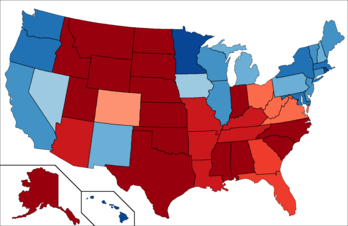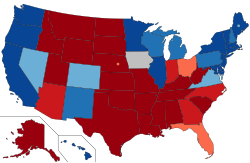 | ||
| ||
|
| ||
 United States presidential election results between 1980 and 2020. Blue shaded states usually voted for the Democratic Party, while red shaded states usually voted for the Republican Party. | ||

The Sixth Party System is the era in United States politics following the Fifth Party System. As with any periodization, opinions differ on when the Sixth Party System may have begun, with suggested dates ranging from the late 1960s to the Republican Revolution of 1994. Nonetheless, there is agreement among scholars that the Sixth Party System features strong division between the Democratic and Republican parties, which are rooted in socioeconomic, class, cultural, religious, educational and racial issues, and debates over the proper role of government.[1]
This party system likely began as a result of a long-term realignment of conservative Southern Democrats into the Republican Party, who were disillusioned by the previous realignment of Progressives into the Democratic Party, though the exact timing of the realignment is usually called into question. Although Barry Goldwater was the first Republican to flip the Dixiecrats in the South in 1964, the South wavered between Republicans, Democrats, and Dixiecrats and wouldn’t fully realign into the GOP until 1984 with Reagan’s landslide victory. This Dixiecratic realignment - known as the Southern Strategy - would allow Republicans to dominate the White House from 1968 to 1992, and eventually Congress after the 1994 Republican Revolution, up until around the 2010s or 2020s.